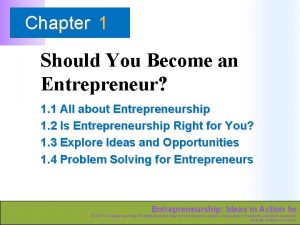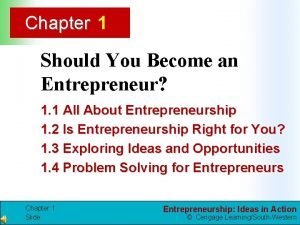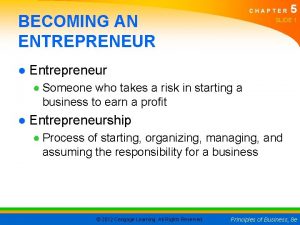Strategic Management and the Entrepreneur Chapter 2 Strategic




































- Slides: 36

Strategic Management and the Entrepreneur Chapter 2 Strategic Mgt Copyright 2006 Prentice Hall Publishing Company 1

A Major Shift. . . From financial capital to intellectual capital. Ø Human Ø Structural Ø Customer Chapter 2 Strategic Mgt Copyright 2006 Prentice Hall Publishing Company 2

Strategic Management n n Chapter 2 Strategic Mgt Is crucial to building a successful business. Involves developing a game plan to guide a company as it strives to accomplish its mission, goals , and objectives, and to keep it on its desired course. Copyright 2006 Prentice Hall Publishing Company 3

Is Strategic Planning Really That Important? n Study of 500 small companies: Ø One of the most significant factors in distinguishing growing companies from those in decline: use of a written business plan. n Another study: Ø Only 12% of small companies had a longrange plan in writing. Chapter 2 Strategic Mgt Copyright 2006 Prentice Hall Publishing Company 4

Strategic Management and Competitive Edge n n Chapter 2 Strategic Mgt Developing a strategic plan is crucial to creating a competitive advantage, the aggregation of factors that sets a company apart from its competitors and gives it a unique position in the market. Example: In-N-Out Burger Copyright 2006 Prentice Hall Publishing Company 5

Key: Core Competencies n Unique set of capabilities a company develops in key areas, such as superior quality, customer service, innovation, teambuilding, flexibility, responsiveness, and others that allow it to vault past competitors. Ø They are what a company does best. Ø Best to rely on a natural advantage (often linked to a company’s “smallness”). Chapter 2 Strategic Mgt Copyright 2006 Prentice Hall Publishing Company 6

Strategic Management Process Step 1: Develop a vision and translate it into a mission statement. Step 2: Assess strengths and weaknesses. Step 3: Scan environment for opportunities and threats. Step 4: Identify key success factors. Chapter 2 Strategic Mgt Copyright 2006 Prentice Hall Publishing Company 7

Strategic Management Process. . . (continued) Step 5: Analyze competition. Step 6: Create goals & objectives. Step 7: Formulate strategies. Step 8: Translate plans into actions. Step 9: Establish accurate controls. Chapter 2 Strategic Mgt Copyright 2006 Prentice Hall Publishing Company 8

Sun Tzu and the Art of Business Principle 1. Capture your market without destroying it. n Principle 2. Avoid your competitors’ strengths and attack their weaknesses. n Principle 3. Use foreknowledge and deception to maximize the power of business intelligence. n Chapter 2 Strategic Mgt Copyright 2006 Prentice Hall Publishing Company 9

Sun Tzu and the Art of Business Principle 4. Use speed and preparation to swiftly overcome the competition. n Principle 5. Use alliances and strategic control points in the industry to “shape” your opponents and make them conform to your will. n Principle 6. Develop your character as a leader to maximize the potential of your employees. n Chapter 2 Strategic Mgt Copyright 2006 Prentice Hall Publishing Company 10

Step 1: Develop a Vision and Create a Mission Statement n n n Vision – an expression of what an entrepreneur stands for and believes in. Vision is based on an entrepreneur’s values. A clearly defined vision: Provides direction Ø Determines decisions Ø Motivates people Ø Chapter 2 Strategic Mgt Copyright 2006 Prentice Hall Publishing Company 11

Step 1: Develop a Vision and Create a Mission Statement n n Mission - addresses question: "What business are we in? ” A written expression of how the company will reflect the owner’s values, beliefs, and vision. Sets the tone for the entire company and guides the decisions people make. Example: Fetzer Vineyards http: //www. fetzer. com/fetzer/wineries/phil osophy. aspx Chapter 2 Strategic Mgt Copyright 2006 Prentice Hall Publishing Company 12

Step 2: Assess Company Strengths and Weaknesses n Strengths Ø Positive internal factors that contribute to accomplishing the mission, goals, and objectives. n Weaknesses Ø Negative internal factors that inhibit the accomplishment of the mission, goals, and objectives. Chapter 2 Strategic Mgt Copyright 2006 Prentice Hall Publishing Company 13

Step 3: Scan for Opportunities and Threats n Opportunities Ø Positive external options the company can employ to accomplish its mission, goals, and objectives. n Threats Ø Negative external forces that inhibit the firm's ability to accomplish its mission, goals, and objectives. Chapter 2 Strategic Mgt Copyright 2006 Prentice Hall Publishing Company 14

External Market Forces Technological Competitive Economic Political and Regulatory Social and Demographic Copyright 2006 Prentice Hall Publishing Company 15

Step 4: Identify Key Success Factors n n Key success factors: relationships between a controllable variable and a critical factor that influence a company’s ability to compete in the market. The keys to unlocking the secrets of competing successfully in a particular market segment. Chapter 2 Strategic Mgt Copyright 2006 Prentice Hall Publishing Company 16

Step 5: Analyze Competitors Analyzing key competitors allows an entrepreneur to: Ø Avoid surprises from existing competitors’ new strategies and tactics. Ø Identify potential new competitors and the threats they pose. Ø Improve reaction time to competitors’ actions. Ø Anticipate rivals’ next strategic moves. Chapter 2 Strategic Mgt Copyright 2006 Prentice Hall Publishing Company 17

Step 5: Analyze Competitors Techniques do not require unethical behavior: Ø Monitor industry and trade publications. Ø Talk to customers and suppliers. Ø Listen to employees, especially sales representatives and purchasing agents. Ø Attend trade shows and conferences Chapter 2 Strategic Mgt Copyright 2006 Prentice Hall Publishing Company 18

Step 5: Analyze Competitors Techniques do not require unethical behavior: Ø Monitor competitors’ employment ads. Ø Conduct searches for patents filed by competitors. Ø Check EPA reports about manufacturing. Ø Search databases for types of materials and equipment competitors are importing. Chapter 2 Strategic Mgt Copyright 2006 Prentice Hall Publishing Company 19

Step 5: Analyze Competitors Techniques do not require unethical behavior: Ø Study competitors' literature and "benchmark" their products and services. Ø Get competitors' credit reports and SEC filings. Ø Check out the local library. Ø Use the World Wide Web to learn more about competitors. Ø Visit competing businesses to observe their operations. Chapter 2 Strategic Mgt Copyright 2006 Prentice Hall Publishing Company 20

Copyright 2006 Prentice Hall Publishing Company 21

Copyright 2006 Prentice Hall Publishing Company 22

Knowledge Management n n The practice of gathering, organizing, and disseminating the collective wisdom and experience of a company’s employees for the purpose of strengthening its competitive position. Knowledge management involves: Taking inventory of the special knowledge the people in the company possess. Ø Organizing that knowledge and disseminating it to those who need it. Ø Chapter 2 Strategic Mgt Copyright 2006 Prentice Hall Publishing Company 23

Step 6: Create Company Goals and Objectives n Goals - broad, long-range attributes to be accomplished. Ø n “BHAGS” – one factor that sets apart successful companies from unsuccessful ones. Objectives - more detailed, specific targets of performance that are S. M. A. R. T. Specific Ø Measurable Ø Assignable Ø Realistic (yet challenging) Ø Timely Ø Chapter 2 Strategic Mgt Copyright 2006 Prentice Hall Publishing Company 24

Step 7: Formulate Strategies n Strategy ØA “road map” that guides a company through a turbulent environment as it seeks to fulfill its mission, goals, and objectives. Ø Focused on the key success factors identified in Step 4. n Mission, goals, and objectives = Ends n Strategy = Means Chapter 2 Strategic Mgt Copyright 2006 Prentice Hall Publishing Company 25

Step 7: Formulate Strategies Three basic strategies: Cost leadership Strategy? Differentiation Focus Chapter 2 Strategic Mgt Copyright 2006 Prentice Hall Publishing Company 26

Three Strategic Options Source of Competitive Advantage Low Cost Position Uniqueness Perceived by the Customer Industry Differentiation Low Cost Differentiation Focus Cost Focus Target Market Niche Copyright 2006 Prentice Hall Publishing Company 27

Cost Leadership n n Goal: to be the low-cost producer in the industry or market segment. Advantages: Reaching buyers who buy on the basis of price. Ø Power to set the industry’s price floor. Ø n Works well when: Buyers are sensitive to price changes. Ø Competing firms sell the same commodity products. Ø A company can benefit from economies of scale. Ø Chapter 2 Strategic Mgt Copyright 2006 Prentice Hall Publishing Company 28

Differentiation n n Company seeks to build customer loyalty by positioning its goods or services in a unique or different fashion. Idea is to be unique at something customers value. Key: Build basis for differentiation on a core competencies, those things that the small company is uniquely good at doing in comparison to its competitors. Example: Audiophile International Chapter 2 Strategic Mgt Copyright 2006 Prentice Hall Publishing Company 29

Focus Company selects one or more customer segments in a market, identifies customers’ special needs, wants, or interests, and then targets them with a product or service designed specifically for them. n Strategy builds on differences among market segments. n Chapter 2 Strategic Mgt Copyright 2006 Prentice Hall Publishing Company 30

Focus Rather than try to serve the total market, the company focuses on serving a niche (or several niches) within that market. n Examples n Ø Frank J. Zamboni and Company Ø Wilson Audio Chapter 2 Strategic Mgt Copyright 2006 Prentice Hall Publishing Company 31

Step 8: Strategies into Action Plans n Create projects by defining: Ø Purpose Ø Scope Ø Contribution Ø Resource requirements Ø Timing Chapter 2 Strategic Mgt Copyright 2006 Prentice Hall Publishing Company 32

Step 9: Establish Accurate Controls n n The plan establishes the standards against which actual performance is measured. Entrepreneur must: Ø identify and track key performance indicators. Ø Take corrective action. Chapter 2 Strategic Mgt Copyright 2006 Prentice Hall Publishing Company 33

Balanced Scorecard n n Chapter 2 Strategic Mgt A set of measurements unique to a company that includes both financial and operational measures Gives managers a quick, yet comprehensive, picture of a company’s overall performance. Copyright 2006 Prentice Hall Publishing Company 34

Balanced Scorecards n Four Perspectives: Ø Customer: How do customers see us? Ø Internal Business: At what must we excel? Ø Innovation and Learning: Can we continue to improve and create value? Ø Financial: How do we look to shareholders? Chapter 2 Strategic Mgt Copyright 2006 Prentice Hall Publishing Company 35

The Balanced Scorecard Links Performance Measures. How do we look to shareholders? Financial Perspective Goals Measures How do customers see us? At what must we excel? Customer Perspective Goals Measures Internal Business Perspective Goals Measures Innovation and Learning Perspective Goals Measures Copyright 2006 Prentice Hall Publishing Company Can we continue to improve and create value? 36
 Strategic competitiveness
Strategic competitiveness Cultural aspects of strategy choice
Cultural aspects of strategy choice Chapter 2 your potential as an entrepreneur
Chapter 2 your potential as an entrepreneur Chapter 1 assessment should you become an entrepreneur
Chapter 1 assessment should you become an entrepreneur Who is
Who is Chapter 1 should you become an entrepreneur
Chapter 1 should you become an entrepreneur Chapter 1 should you become an entrepreneur
Chapter 1 should you become an entrepreneur Tirole
Tirole Hình ảnh bộ gõ cơ thể búng tay
Hình ảnh bộ gõ cơ thể búng tay Ng-html
Ng-html Bổ thể
Bổ thể Tỉ lệ cơ thể trẻ em
Tỉ lệ cơ thể trẻ em Voi kéo gỗ như thế nào
Voi kéo gỗ như thế nào Tư thế worm breton
Tư thế worm breton Chúa yêu trần thế
Chúa yêu trần thế Môn thể thao bắt đầu bằng chữ f
Môn thể thao bắt đầu bằng chữ f Thế nào là hệ số cao nhất
Thế nào là hệ số cao nhất Các châu lục và đại dương trên thế giới
Các châu lục và đại dương trên thế giới Công thức tính thế năng
Công thức tính thế năng Trời xanh đây là của chúng ta thể thơ
Trời xanh đây là của chúng ta thể thơ Cách giải mật thư tọa độ
Cách giải mật thư tọa độ Phép trừ bù
Phép trừ bù độ dài liên kết
độ dài liên kết Các châu lục và đại dương trên thế giới
Các châu lục và đại dương trên thế giới Thơ thất ngôn tứ tuyệt đường luật
Thơ thất ngôn tứ tuyệt đường luật Quá trình desamine hóa có thể tạo ra
Quá trình desamine hóa có thể tạo ra Một số thể thơ truyền thống
Một số thể thơ truyền thống Cái miệng nó xinh thế
Cái miệng nó xinh thế Vẽ hình chiếu vuông góc của vật thể sau
Vẽ hình chiếu vuông góc của vật thể sau Biện pháp chống mỏi cơ
Biện pháp chống mỏi cơ đặc điểm cơ thể của người tối cổ
đặc điểm cơ thể của người tối cổ Giọng cùng tên là
Giọng cùng tên là Vẽ hình chiếu đứng bằng cạnh của vật thể
Vẽ hình chiếu đứng bằng cạnh của vật thể Phối cảnh
Phối cảnh Thẻ vin
Thẻ vin đại từ thay thế
đại từ thay thế điện thế nghỉ
điện thế nghỉ




























































